Related Research Articles

Pleurotus is a genus of gilled mushrooms which includes one of the most widely eaten mushrooms, P. ostreatus. Species of Pleurotus may be called oyster, abalone, or tree mushrooms, and are some of the most commonly cultivated edible mushrooms in the world. Pleurotus fungi have also been used in mycoremediation of pollutants, such as petroleum and polycyclic aromatic hydrocarbons.

The Entolomataceae, also known as Rhodophyllaceae, are a large family of pink-spored terrestrial gilled mushrooms which includes the genera Entoloma, Rhodocybe, and Clitopilus. The family collectively contains over 1500 species, the large majority of which are in Entoloma. Genera formerly known as Leptonia and Nolanea, amongst others, have been subsumed into Entoloma. Mushrooms in the Entolomataceae typically grow in woodlands or grassy areas and have attached gills, differentiating them from the Pluteaceae, which have free gills.

Pleurotus dryinus is a species of fungus in the family Pleurotaceae. It grows on dead wood and is also a weak pathogen; infecting especially broad-leaved trees.
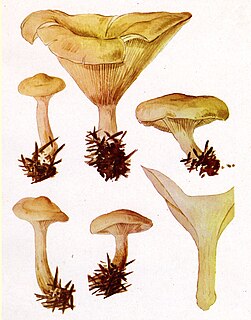
Paralepistopsis amoenolens, commonly known as the paralysis funnel, is an agaric fungus ascribed to the large genus Clitocybe. It was originally described from Morocco in 1975 as Clitocybe amoenolens by the French mycologist Malençon. It was discovered to be poisonous after several people had consumed specimens all found in the alpine Maurienne valley in the Savoie department over three years. They had mistaken it for the edible common funnel cap or Paralepista flaccida.

Echinoderma asperum or Lepiota aspera, sometimes known commonly as the freckled dapperling, is a large, brownish, white-gilled mushroom, with a warty or scaly cap. It lives in woodland, or on bark chips in parks, and gardens.
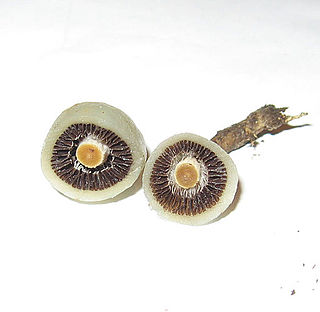
Weraroa was a genus of mushrooms from the families Hymenogastraceae and Strophariaceae. The genus was initially described by mycologist Rolf Singer in 1958 to accommodate the single species Secotium novae-zelandiae reported by Gordon Herriott Cunningham in 1924. It was thought that the genus represented an intermediary evolutionary stage between a hypogeous (underground) ancestor and the related epigeous genus Stropharia. Advances in phylogenetics and taxonomic changes since 1958 found it contained unrelated species from multiple genera. It is now considered a synonym of the genus Psilocybe.
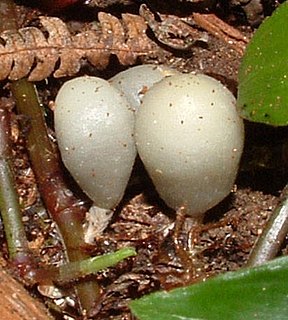
Psilocybe weraroa is a secotioid fungus in the family Hymenogastraceae. It is endemic to New Zealand. This species is closely related to Psilocybe cyanescens and is in both the section Cyanescens and the Cyanescens phylogenetic clade. As a bluing member of the genus Psilocybe it contains the psychoactive compounds psilocin and psilocybin.
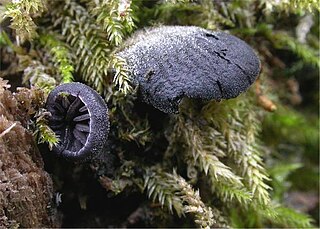
Resupinatus is a genus of fungi in the family Tricholomataceae. Species are saprobic, and often found growing on the underside of decaying wood or sides of decaying woody substrates. The generic name is derived from the Latin resupinus.
Limnoperdon is a fungal genus in the monotypic family Limnoperdaceae. The genus is also monotypic, as it contains a single species, the aquatic fungus Limnoperdon incarnatum. The species, described as new to science in 1976, produces fruit bodies that lack specialized structures such as a stem, cap and gills common in mushrooms. Rather, the fruit bodies—described as aquatic or floating puffballs—are small balls of loosely interwoven hyphae. The balls float on the surface of the water above submerged twigs. Experimental observations on the development of the fruit body, based on the growth on the fungus in pure culture, suggest that a thin strand of mycelium tethers the ball above water while it matures. Fruit bodies start out as a tuft of hyphae, then become cup-shaped, and eventually enclose around a single chamber that contains reddish spores. Initially discovered in a marsh in the state of Washington, the fungus has since been collected in Japan, South Africa, and Canada.

Skeletocutis is a genus of about 40 species of poroid fungi in the family Polyporaceae. The genus has a cosmopolitan distribution, although most species are found in the Northern Hemisphere. It causes a white rot in a diverse array of woody substrates, and the fruit bodies grow as a crust on the surface of the decaying wood. Sometimes the edges of the crust are turned outward to form rudimentary bracket-like caps.
Episphaeria is a genus of fungus in the Agaricales. The genus is monotypic, and contains the single rare species Episphaeria fraxinicola, found in Europe. Its familial position is not known with certainty. The tiny fruit bodies of the fungus resemble minute, white cups that grow scattered or in groups on the bark of ash trees.

The cyphelloid fungi are a group of fungi in the Basidiomycota that have disc-, tube-, or cup-shaped basidiocarps, resembling species of discomycetes in the Ascomycota. They were originally referred to the genus Cyphella and subsequently to the family Cyphellaceae, but are now known to be much more diverse and are spread through several different genera and families. Since they are often studied as a group, it is convenient to call them by the informal (non-taxonomic) name of "cyphelloid fungi". Better known cyphelloid genera include Calyptella, with stalked, cup- or bell-like fruit bodies; Lachnella, with conspicuous, hairy-margined, disc-like fruit bodies; Flagelloscypha with smaller, but equally hairy, cup-like fruit bodies; Henningsomyces with tube-like fruit bodies; and Merismodes with clustered, hairy, cup-like fruit bodies.
Rhodocybella is a genus of cyphelloid fungi in the Entolomataceae family. It contains just one known species, Rhodocybella rhododendri, which is found in North America on Rhododendron stems after heavy rain.

Paralepista flaccida is a species of mushroom found across the Northern Hemisphere. It is known to form fairy rings.
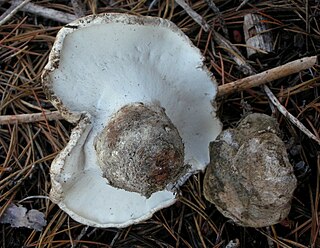
Boletopsis grisea is a species of fungus in the family Bankeraceae. The fruit bodies are gray, fleshy polypores that grow on the ground in a mycorrhizal association with Scots pine. It is found in Asia, North America, and Europe.
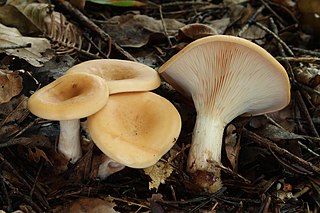
Paralepista is a genus of mushrooms in family Tricholomataceae. Until 2012 its member species were generally assigned either to Lepista or to Clitocybe.

Gymnopus fusipes is a parasitic species of gilled mushroom which is quite common in Europe and often grows in large clumps. It is variable but easy to recognize because the stipe soon becomes distinctively tough, bloated and ridged.
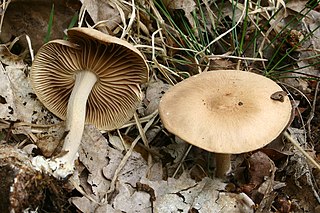
Gymnopus peronatus is a species of gilled mushroom which is common in European woods. The English name wood woolly-foot has been given to this species.

Infundibulicybe gibba is a species of gilled mushroom which is common in European woods. In English it is sometimes known as the common funnel.
References
- ↑ See the Global Biodiversity Information Facility entry.
- ↑ See the type specimen entry at the Academy of Natural Sciences Philadelphia Herbarium site.
- ↑ See the New Zealand Fungi page.
- ↑ See this page image available through the Cybernome entry.
- ↑ See the Species Fungorum entry.
- ↑ "Phylogenetic relationships of cyphelloid homobasidiomycetes" (PDF). Molecular Phylogenetics and Evolution. Amsterdam: Elsevier. 33 (2): 501–515. 2004. doi:10.1016/j.ympev.2004.06.007. PMID 15336682. Archived from the original (PDF) on 2011-07-19.